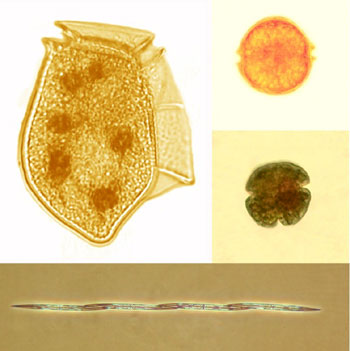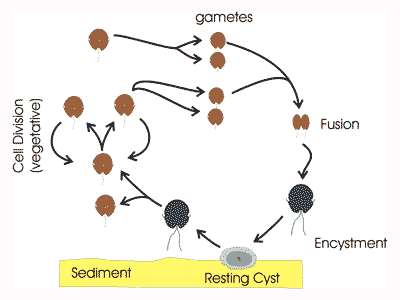| 2003 |

|
YEAR BOOK |
The Martin Ryan Institute, NUI Galway
|
Harmful algal blooms
|


A major public health problem caused by HABs around the Irish coast is associated with the contamination of shellfish with biotoxins. Ingestion by humans can result in a variety of serious and unpleasant syndromes. These are known as Diarrheic Shellfish Poisoning, for the most part caused by biotoxins present in Dinophysis, Azasparacid Shellfish Poisoning where Protoperidinium is implicated, Amnesic Shellfish Poisoning caused by the presence of domoic acid, a toxin which is produced by the diatom Pseudo-nitzschia, and Paralytic Shellfish Poisoning which results from ingestion of highly potent saxitoxins derived from Alexandrium. Another dinoflagellate, Karenia mikimotoi, is responsible for the formation of red tides which have caused mortalities of both marine fauna and of farmed finfish and shellfish around the coastline. Monitoring for the phytoplankton and their biotoxins is a costly and time-consuming process and is the responsibility of the Marine Institute.
Investigations into the occurrence of HABs have been carried out at NUI, Galway since the late 1980s. Research has shown that many harmful events arise from harmful populations which are carried into inshore areas from the open ocean by currents which are driven by surface winds. This has allowed a predictive element to HAB occurrences based on weather forecasts. The application of remote sensing by using satellite derived images of the sea surface has also been given a thorough appraisal.
A number of HAB projects have recently started within the Martin Ryan Institute at NUI, Galway. These have been funded through the Higher Education Authority Programme for Research in Third Level Institutions (Cycle 3) and the Marine Institute/National Development Plan programme. They involve the development of species specific molecular probes for the rapid detection of harmful species, modelling the dynamics of Alexandrium , and BOHAB: the Biological Oceanography of Harmful Algal Blooms.
Monitoring phytoplankton using traditional light microscopy techniques is a highly skilled and time-consuming process. In addition, the similarity in the appearance of many species within a particular genus means that on occasion more sophisticated identification techniques such as electron microscopy are essential. The development of fluorescent dyes which attach to the nucleic acid of a single species will greatly ease the process. Collaborative work with the National Development Corporation laboratory situated on campus at Galway is currently underway developing probes for Alexandrium and Pseudo-nitzschia.

BOHAB is a three year programme which is aimed at establishing the link between oceanography and the development of harmful blooms along the west coast of Ireland. With partners from the Marine Institute and the Woods Hole Oceanographic Institution, USA, scientists at the Martin Ryan Institute are studying the dynamics of harmful events, specifically looking at the relationship between changes within phytoplankton communities, levels of toxin within shellfish tissue, and oceanographic events. The work incorporates use of the research vessel Celtic Voyager for field studies, the deployment of moored oceanographic instrumentation and studies on the life cycles of harmful species, and is complemented by ongoing research within the partner institutions.
Contact: Dr Robin Raine, The Martin Ryan Institute, NUI Galway; E-mail: [email protected]